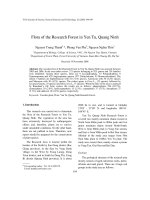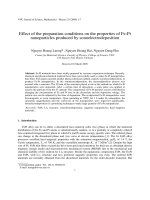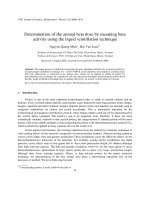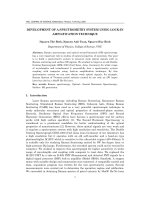Báo cáo " Characteristics of the voi mep massif’s altitudinal belt differentiation " doc
Bạn đang xem bản rút gọn của tài liệu. Xem và tải ngay bản đầy đủ của tài liệu tại đây (756.1 KB, 8 trang )
VNU. JOURNAL OF SCIENCE, Earth sciences, T.xxIII, N
0
1, 2007
10
Characteristics of the voi mep massif’s
altitudinal belt differentiation
Truong Quang Hai
Institute of Vietnamese Studies and Development Sciences, VNU
ABSTRACT. The Voi Mep massif of the Truong Son range, having the highest peak in the
Quang Tri area (1739m), is composed of granite and granodiorite intrusive rocks in Ben
Giang-Que Son complex. This massif is fairly isometric with characteristic landforms
comprising: remnants of old pediment surfaces, mountain slopes and valleys with steep
profiles. The massif area has a regular altitudinal differentiation manifested in the formation
of two climatic belts: tropical humid climatic belt, subtropical humid climatic belt; two
altitudinal soil belts: red yellow soil belt and red yellow humus soil belt; four altitudinal
vegetation cover types: evergreen broadleaf closed forest, mixed broadleaf/needleleaf
forest, needleleaf forest and association of Arundinaria sat. The combination and interaction
of natural components led to the formation of two altitudinal landscape belts: mountain foot
tropical landscape belt and medium montane subtropical landscape belt.
1. The problem
Altitudinal belts or altitudinal zones are/represent altitudinal landscape zones in
the mountainous region, relatively homogeneous in natural conditions, with the
altitudinal range determined by latitudinal locations of the area relative to horizontal
natural zones, as well as topographic, geologic conditions (Xpiridonov, 1980). Massifs
can be differentiated into altitudinal landscape zones and component natural zones
such as altitudinal climatic, pedologic and biologic belts (Avessalomova et al., 2004;
Zhang Baipang, 2002; Corbutt and Edwards, 2004). Thai Van Trung (1999)
distinguished five groups of generating ecological factors: geography-topography,
climatic-hydrologic regime, mother rocks-soils, flora and fauna and humans. Out of
these, topographic elevations are factors generating altitudinal belts.
In Vietnam, the great regularities of geographic space differentiation take place,
which are latitudinal, azonal tectonic-topographic and altitudinal belt differentiation
regularities. The altitudinal belt differentiation takes place commonly in all
mountainous regions, but since hills and mountains are often highly dissected,
altitudinal belts have small areas, also the nature of each belt depends closely on its
location, altitude, shape and direction of the mountain range or massif, hence it has a
profound locality (Vu Tu Lap, 1999). The study of altitudinal landscape belts at the Voi
Mep massif contributes to the revealing of natural differentiation features of Truong
Son range in the western part of Quang Tri Province.
Characteristics of the Voi Mep massif’s altitudinal belt differentiation
11
2. Topographic features of the Voi Mep massif
Voi Mep massif with the highest peak (1739m) of the same name belonging to the
Truong Son range, located in west Quang Tri, is composed of granite, granodiorite
intrusive rocks in Ben Giang - Que Son complex. This is a relatively isometric, steeply
sloping massif with an asymmetry: eastern and southern slopes are smaller than
western and northern ones. In this massif there are many landforms characteristic of
medium high mountains such as scarps, mountain peak being remnants of old
pediments, valleys having steep profiles with high water falls (Truong Quang Hai,
2006). The main landforms include:
- Top surface on elevations of 800-1000m and 1400-1600m: pediment surfaces
exist in the form of slightly convex undulated, narrow water divide surfaces. On the
background of an old weathering crust also emerge granitic blocks of different sizes,
rather well eroded, creating a peculiarity of the top surface. Currently this surface is
modified by surface washout process.
- Slopes on granites: there are many steep slopes on the west of the massive,
developed along fissures, tectonic faults cutting into granites. The origin of these
surfaces are rapid gravity processes, including falls and collapses, the slope of this
surface is greater than 25
o
, vertical in places. Straight profiled, less dissected by
perennial and non-perennial streams, almost all surfaces do not present a leveled
structure. Loose formations covering the surface are usually very thin (<0.5m), occurring
rolling boulders, rock fields in unstably cemented conditions. Gravitational processes
have continuously developed to present.
- Gentlely inclined planes on mountain slopes: dissection of the pediment surface
by erosion-denudation has formed terraced surfaces on mountain slopes. Between steep
slopes are gently inclined planes, they create a topographic diversity.
3. Altitudinal differentiation of climatic conditions
According to the rule of altitudinal temperature gradient (the temperature
decreases by 0.5-0.6
o
C every 100m elevation increase), combined with the validation
results during the interdisciplinary field surveys carried out by the Faculty of
Geography, VNU in October 2004, April 2005 and September 2006, the area of Voi Mep
mountain can be divided into two climatic belts with gradual transitions:
- The tropical humid belt with the elevations under 800m: mean annual air
temperature above 20
0
C, the cold period lasts 4 months, from November to March; dry
season of about 3 months, from January to March. This mountain foot belt has a
tropical humid climate with a cool winter. The temperature in January (the coldest
month) can go down below 15
o
C.
Truong Quang Hai
12
- The subtropical humid belt with elevations from 800 to 1739m (Voi Mep peak):
the mean annual air temperature below 20
o
C, the coldest period can last from May to
December, the dry season lasts less than 3 months. The mountain peak area has a
rather special subtropical climate, mean annual temperature below 15
o
C, not below
9
o
C, warm year round with fogs and cold winds.
4. Characteristics and altitudinal differentiation of pedologic
cover
Variations in moisture and temperature background associated with altitudinal
belts are the causes that decrease feralite forming processes and increase humus
formation. The pedologic cover in the area is differentiated into two soil types:
- Red yellow soils developed on granites (Fa): distributed densely in the
mountain foot belt with elevations of less than 750m on the eastern slope and less
than 800m on the western slope. Generally, the area topography has large slopes and
is strongly dissected. The results of soil profile analyses show a mechanical
composition of medium clay, with acidic reaction (pH
kcl
from 3.6-5.2), medium humus
content (1.1-2.6%), total P content medium good, total N content of the top layer good
and decreasing with depth. Total alkaline exchange cation is low in all layers (<5.0
mE/100g of soil).
- Yellow red humic soils on granites (Ha): distributed mainly at elevations above
750-800m. The soil profile usually has a coarse humic layer, peaty humus followed by a
thin soil layer with debris. The humus formation process is a dominant process, weak
feralite formation process. The soil has a light clay mechanical composition, sand
content in the top layer is from 65-68% and decreases with depth. Soil reactions are
acidic ((pH
kcl
of all layers below 4.5), humus content of top layer rich (>4%), total N rich
(>0.24%), lower layers medium good, total P medium good (0.06-0.1%). Hydrolytic
acidity in lower layers is below 15.00 mE/100g soil, total exchange cation in soil: 4.0-4.6
mE/100g soil, base saturation less than 50%. Currently, almost all this area is covered
by natural forest vegetation, little disturbed by humans.
5. Characteristics and altitudinal differentiation of vegetation
cover
Changes in humid thermal conditions associated with altitudes have created a
rather diverse and peculiary vegetation cover in the area. The Voi Mep vegetation
cover consists of 4 main types: tropical humid evergreen broadleaf closed forest,
subtropical humid mixed broadleaf / needleleaf closed forest, needdleleaf forest and Sat
association (Figure 1).
Characteristics of the Voi Mep massif’s altitudinal belt differentiation
13
1. Low montane tropical humid evergreen broadleaf closed forest
Commonly distributed at elevations below 800m in the northern and eastern parts
of Voi Mep. The forest structure is rather intact, comprising all five canopy layers:
- Above canopy layer is above 30m high, some trees up to 40m high, diameter up
to above 2m. Frequently found species are Dracontomelom duperreanum, Tetrameles
nudiflora, Aglaia gigantea, In the elevation range of 600m have occurred Podocarpus
nerriifolius; to 700-800m occur Dacryum elatum.
- Ecological dominance layer, 20-30m high, completely covered, with Fagaceae
species from genera Quercus, Lithocarpus, Castanopsis, Re species in genus
Cinnamomum, Michelia mediocris, Rhodoleia championii, Callophylum sp, Dacryodes
dungii.
- Understory layer comprises small tree species in families of Mytarceae,
Euphorbiaceae, Annonaceae, Ulmaceae, Myristcaceae, Elaeocarpaceae.
- Shrub layer 2-8m high comprising plant species in Don nem family, small
woody plants of the upper layer.
- Herb layer, devoid of plants and species in family Acanthaceae with a height
less than 2m.
Figure 1. Voi Mep massif’s altitudinal differentiation of vegetation cover
Truong Quang Hai
14
2. Subtropical humid mixed broadleaf / needleleaf closed forest
The forest is commonly distributed at elevations above 800m of the Voi Mep area,
in Dong To Rang, Dong Sa Mui (Nortwest Voi Mep), Dong Tri (South Voi Mep). The
forest structure is simpler than that of low montane forest, usually lacking the above
canopy layer, uniform canopy, closed, relatively uniform tree diameter in the
dominance layer.
- At elevations of 800-900m, the forest structure comprises: forest canopy layer,
20-25 high, 40-45cm diameter, some trees have their diameter up to 1.5m; below the
forest canopy layer is the understory layer, 10-20m high, shrub and small woody plant
layer 2-8m high, lowermost is the herb layer.
- At elevations of 1000-1200m, trees in the forest canopy layer are only about 15-
20m high, with open cover. Under the forest canopy one can still differentiate a layer of
small trees and shrub 2-10m high, lowest is the herb layer. The forest species
composition is quite complicated, however there is a clear predominance of plants in
family Lauraceae such as Cinnamomum burmannii; Cinnamomum mairei; family
Fagaceae such as Castanopsis indica, Lithocarpus bacgiangensis, L. fenestratus, L.
garretliana, Quercus quangtriensis.
Gymnosperm plants start to occur at 600m elevation and increase in the number
of individuals with altitude. The encountered species include Dacrydium elatum,
Keteleeria evelyniana, Podocarpus imbricatus or Dacrycarpus imbricatus, Podocarpus
neriifolius. Some species in temperate families also occur in the forest such as
Carpinus viminea, Betulaceae family, Acer laurinum.
3. Needleleaf forest
Needleleaf plants participate in the forest structure from elevations above 600m.
But they only form a typical needleaf forest at elevations of 1200-1500m in conditions
of low temperature, permanent fogs, continuing high humidity.
The forest structure comprises three layers:
- Dominant forest woody plants with a height of about 20m, tree diameter of
about 50-60cm, sparse cover of about 60-70%, dominant species of Dacrydium elatum
and Podocarpus imbricatus. The tree trunk is fully covered in mosses.
- Understory layer with a height from 8-15m, tree diameter of 10-15cm, grows
fairly densely. Frequently found species include broadleaf trees from family Fagaceae,
Cinnamomum mairei from family Lauraceae, Acer tonkinensis, family Aceracea. In
many places, Podocarpus neriifolius grows into pure stands in this layer.
Characteristics of the Voi Mep massif’s altitudinal belt differentiation
15
- Layer of shrubs, herbs and climbing plants comprising species such as
Dicranopteris dichotoma, Melastoma saigonesis, Diplazium lobbianum, Padanus sp,
Arundinaria sat. Herbacious species include Scipus articulatus and Carex cruciata, Scleria
from family Cyberaceae, this species is about 20cm high and grows close to the ground.
Climbing plants include Gnetum montanum, Smilax, Calamus, some species of
family Fabaceae, Subplants are represented by Dendrodium ihyrsiflorum with very
beautiful flowers.
4. Association of Arundinaria sat, special vegetation cover at the mountain peak
From 1500m upward, the terrain is always steep, thin soils with black humus,
strongly windy and foggy.
The vegetation cover is characterized by Arundinaria sat from family Poaceae,
purely and densely grown with a height ranging from 1-1.5m. Also, in this cover there
are some species of small woody plants, shrubs, herbs and climbing plants. Small
woody plants are Podocarpus neriifolius, Dacrydium elatum, Manglietia chevalierii,
Eurya tonkinensis, Scheffelera kontumensis, They are about 3-4m high, creating a
belt ouside the cover of Arundinaria sat.
Species of shrubs, herbs and climbing plants are of Camellia sinensis, Melastoma
saigonensis, Carex cruciata, C. filicina, Scleria, Leersia hexandra, Rubus chaetophorus,
Catimbium malaccense, Selaginella rolandi-principis, growing below the canopy of
Arundinaria sat.
6. Altitudinal landscape belts
Natural components such as climate, pedology, vegetation cover exhibit regular
altitudinal differentiation, where climatic belts have gradual transitions, pedologic and
vegetation belts have fairly clear boundaries located at 750-800m elevations. The
boundaries of belts are usually found at lower elevations on the northern and eastern
slopes, at higher elevations on the southern and western slopes. With a viewpoint of
landscape as specific territories, with the same process of genesis and development,
relatively homogeneous in natural conditions such as geological background, terrain,
climate types, regular association of soil types and biological communities (Xpiridov,
1980), it is possible to divide the Voi Mep Massif into two altitudinal landscape belts:
tropical mountain foot belt to 750-800m elevations, common distribution of low
montane tropical humid closed forest on red yellow soils developed on granites (Fa);
medium montane subtropical belt at above 750-800m elevations, development of
subtropical humid mixed broadleaf/needleleaf forest, needleleaf forest and the
association of Arundinaria sat on red yellow humus soils formed on granites (Ha).
Truong Quang Hai
16
7. Conclusions
The natural components of the massif are regularly differentiated due to
decreasing temperatures and increasing air humidity with topographic elevations,
leading to the formation of two climatic belts: tropical humid belt (<800m), subtropical
humid belt (>800m); two altitudinal soil belts: red yellow soil belt (<750-800m) and red
yellow humus soil belt (>750m-800m); four altitudinal vegetation covers: evergreen
broadleaf closed forest (<800m), mixed broadleaf/needleleaf closed forest (800-1200m),
needleleaf forest (1200-1500m) and the association of Arundinaria sat (>1500m). The
boundaries of climatic belts exhibit gradual transitions, those of soil and vegetation
belts are fairly clearly shown on topographic surfaces.
The combination and interaction of natural components led to the formation of
two altitudinal landscape belts: mountain foot tropical landscape belt and medium
montane subtropical belt. Their boundary lies at 750m altitude on northern and eastern
slopes, 800m on southern and western slopes.
* This paper is completed with the support of the Fundamental Research Program,
Project Code: 717506.
References
[1] Avessalomova, I., Petroshina, M., Samoylova, G. (2004), Spatial organization of mountain
landscapes, VISNIK LVIV UNI, Ser. Geogr. (In Russian), No. 31, pp. 368-374.
[2] Corbutt, C. and Edwards, T. J. (2004), The flora of the Drakenberg Alpine Center.
Edinburgh Journal of Botany, No 60, pp. 581-607.
[3] Thai Van Trung (1999), Tropical forest ecosystems in Vietnam. Science and Technique
Publisher (in Vietnamese), Hanoi, pp. 297.
[4] Truong Quang Hai (Ed.) (2006), Investigation, Assessment of territorial potential for
planning the ecotourism development in the Quang Tri's territory, Scientific project
report, Archived in Science and Technology Department of Quang Tri Province, pp. 300.
[5] Vu Tu Lap (1999), Physical geography of Vietnam, Education Publisher, Hanoi, pp. 346.
[6] Xpiridonov, A. (1980), Dictionary of physical geographical terms in four languages
(Russian-English-German-French), Soviet Dictionary Publisher, Moscow, pp. 703.
[7] Zhang Baiping (2002), Digital spectra of altitudinal belts and their hierarchical system,
Journal of Mountain Science (in Chinese), 20(6), pp. 660-665.
VNU. JOURNAL OF SCIENCE, Earth sciences, T.xxIII, N
0
1, 2007
10









